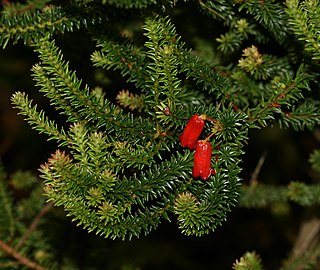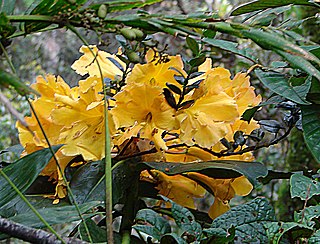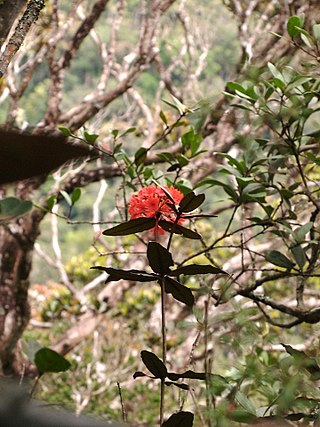
Mount Kinabalu is the highest mountain in Borneo and Malaysia. With an elevation of 4,095 metres (13,435 ft), it is third-highest peak of an island on Earth, and 20th most prominent mountain in the world. The mountain is located in Ranau district, West Coast Division of Sabah, Malaysia. It is protected as Kinabalu Park, a World Heritage Site.

Montane grasslands and shrublands are a biome defined by the World Wildlife Fund. The biome includes high elevation grasslands and shrublands around the world. The term "montane" in the name of the biome refers to "high elevation", rather than the ecological term which denotes the region below treeline.
Elaeocarpus inopinatus is a species of flowering plant in the Elaeocarpaceae family. It is a tree endemic to Borneo where it is confined to Sabah.

Dubautia arborea, the tree dubautia or Mauna Kea dubautia, is a species of flowering plant in the family Asteraceae. A member of the silversword alliance, it is endemic to the island of Hawaiʻi. It is a shrub or small tree. It is an endangered species that is threatened by feral grazing animals.

The mountain blackeye, sometimes referred to as the olive blackeye or simply black-eye, is a species of passerine bird in the family Zosteropidae. It is endemic to the highest mountains on the island of Borneo. It is known from both Malaysian states on the island, and four of the five Indonesian provinces, but has never been recorded in Brunei. Typically found at elevations above 1,800 m (5,900 ft), the mountain blackeye sometimes moves to lower altitudes during periods of drought. There are four subspecies, which show clinal variations in size and coloring. Birds in the north are largest, darkest, and proportionately longer-tailed, while those further south are smaller, paler, and proportionately shorter-tailed. Adults are dark olive-green with a sharply-pointed, bright yellow-orange bill and a small dark mask connecting black lores with a black eye-ring. The subspecies show varying amounts of yellow in their plumage, particularly on the face and underparts. Young birds resemble their parents, but have less brightly colored bills.
Melicope sororia is a species of plant in the family Rutaceae. It is endemic to Borneo where it is confined to Sabah.

The Eastern Himalayan alpine shrub and meadows is a montane grasslands and shrublands ecoregion of Bhutan, China, India, Myanmar, and Nepal, which lies between the tree line and snow line in the eastern portion of the Himalaya Range.

The Northwestern Himalayan alpine shrub and meadows is a montane grasslands and shrublands ecoregion of the elevations of the northwestern Himalaya of China, India, and Pakistan.

The Kinabalu shrew is a species in the family Soricidae. It is endemic to the mountain Mount Kinabalu on Borneo, and its sister peak, Mount Tambuyukon.

Montane ecosystems are found on the slopes of mountains. The alpine climate in these regions strongly affects the ecosystem because temperatures fall as elevation increases, causing the ecosystem to stratify. This stratification is a crucial factor in shaping plant community, biodiversity, metabolic processes and ecosystem dynamics for montane ecosystems. Dense montane forests are common at moderate elevations, due to moderate temperatures and high rainfall. At higher elevations, the climate is harsher, with lower temperatures and higher winds, preventing the growth of trees and causing the plant community to transition to montane grasslands and shrublands or alpine tundra. Due to the unique climate conditions of montane ecosystems, they contain increased numbers of endemic species. Montane ecosystems also exhibit variation in ecosystem services, which include carbon storage and water supply.
The ecology of the Himalayas varies with climate, rainfall, altitude, and soils. The climate ranges from tropical at the base of the mountains to permanent ice and snow at the highest elevations. The amount of yearly rainfall increases from west to east along the southern front of the range. This diversity of climate, altitude, rainfall and soil conditions supports a variety of distinct plant and animal species, such as the Nepal gray langur

Pterophylla fraxinea, formerly known as Weinmannia fraxinea, is a tree in the family Cunoniaceae. It grows up to 40 metres (130 ft) tall. The bark is grey to dark brown. Inflorescences bear up to three pairs of flowers. The specific epithet fraxinea is from the Latin meaning "ash tree", referring to the leaves' resemblance to those of the genus Fraxinus.
Heptapleurum stramineum is a species of flowering plant in the family Araliaceae. It is a scrambling tree endemic to Papua New Guinea.
Arsi Mountains National Park is a national park in Arsi Zone of Oromia Region in Ethiopia. It protects a portion of the Ethiopian Highlands, and includes montane forests, subalpine heath, and alpine grasslands and shrublands. The park was designated in 2011, and covers an area of 10876 km2.

Rhododendron ericoides is a species of rhododendron native to Borneo. It is found only on Mount Kinabalu. It is native to subalpine and alpine shrublands above 2,600 meters elevation.
Ilex kinabaluensis is a species of tree native to Mount Kinabalu on Borneo.

Rhododendron lowii is a species of rhododendron native to Borneo. It is found in the Crocker Range and Mount Kinabalu of Sabah state, in the northeastern portion of the island.

Rhododendron rugosum is a species of rhododendron native to Borneo. It is found in the high mountains, including Mount Kinabalu, in Sabah state of northeastern Borneo.

Rhododendron fallacinum is a species of rhododendron native to Borneo.
Pterophylla clemensiae, formerly known as Weinmannia clemensiae, is a species of plant in the family Cunoniaceae. It is endemic to Borneo. It is a tree or treelet growing up to 10 metres tall.














